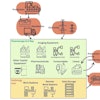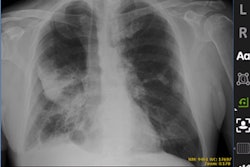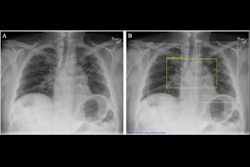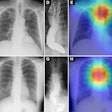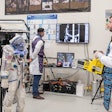Dear AuntMinnie Member,
Dark-field x-ray imaging -- which measures ultrasmall-angle scattering that takes place at material interfaces within targets -- has so far mainly been investigated for use in pulmonary imaging.
Recently, however, German developers of the technology showed it is feasible to use it to distinguish between osteoporotic and non-osteoporotic spine samples, and they have taken the work a step further in a study published November 4 in European Radiology Experimental. Click here for the details.
Meanwhile, more investigations evaluating commercially available AI chest x-ray models in real-world settings have begun to be published. These studies are necessary, since the impact of these algorithms on clinical practice remains unclear, as the authors of the research highlighted in the following articles suggest:
- A group at Case Western Reserve University deployed a model that detects pneumothorax in their hospital’s intensive care unit, with promising results.
- Changi General Hospital clinicians in Singapore recently deployed CXR Triage by Lunit in their hospital’s emergency department, with findings suggesting the software could help reduce turnaround times by 77%.
- Imagen Technologies scientists suggested the company’s Chest-CAD software (cleared in the U.S. in 2021) can lift nonradiologists' x-ray interpretation skill levels.
Yet it’s not all great news on AI. Investigators at Drexel University in Philadelphia recently found that while four commercially available natural language processing tools for chest x-ray report annotation show high overall accuracy, they also exhibit significant age-related bias.
Additionally, a group at Harvard Medical School suggested that freely available large language models may overcome limitations associated with proprietary models like GPT-4 when extracting findings from chest x-ray reports.
Last on AI, the U.S. Centers for Disease Control and Prevention (CDC) may be getting in on the game, with a recent study suggesting the agency is considering the use of the technology to back up its tuberculosis screening program for immigrants and refugees.
We also keep abreast of dual-energy x-ray absorptiometry studies, with one by a group in the U.K. recently suggesting that vitamin D supplementation during pregnancy results in greater bone mineral density in children up to age 7.
Closing on a light note, click here if you’d like to see a video of Wilhelm Conrad Roentgen explaining why he named his 1895 discovery “x-rays.” The video was published on Vimeo and made available in a recent article in Cureus.
For more x-ray news, be sure to check in regularly with our Digital X-Ray content area.
Will Morton
Editor
AuntMinnie.com



